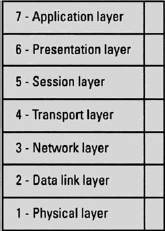The OSI Reference Model
The OSI reference model is a seven-layer model that was developed by the International Standards Organization (ISO) in 1978. The OSI model is a framework for international standards that can be used for implementing a heterogeneous computer network architecture. The OSI architecture is split into seven layers. Figure below illustrates the seven layers of the OSI model. Each layer uses the layer immediately below it and provides a service to the layer above. In some implementations a layer may itself be composed of sublayers.

The physical layer addresses the physical link and is concerned with the signal voltage, bit rate, and duration. The data link layer is concerned with the reliable transmission of data across a physical link. In other words, getting a signal from one end of a wire to the other end. It handles flow control and error correction. The network layer handles the routing of data and ensures that data is forwarded to the right destination. The transport layer provides end-to-end control and constructs the packets into which the data is placed to be transmitted or "transported" across the logical circuit. The session layer handles the session set-up with another network node. It handles the initial handshake and negotiates the flow of information and termination of connections between nodes. The presentation layer handles the conversion of data from the session layer, so that it can be "presented" to the application layer in a format that the application layer can understand. The application layer is the end-user interface. This includes interfaces such as browsers, virtual terminals, and FTP programs.
In this tutorial:
- Threats and Attacks
- The OSI Reference Model
- TCP/IP Protocol Suite
- Threats, Vulnerabilities, and Attacks
- Attacks
- Viruses
- Worm
- Trojan Horses
- Trap Doors
- Logic Bombs
- Port Scanning
- Spoofs
- Sequence Number Spoofing
- DNS
- DNS Poisoning
- Redirects
- Password Cracking
- Sniffing
- War Dialing
- Denial of Service
- Ping of Death
- SYN Flooding
- SPAM
- Smurf Attack
